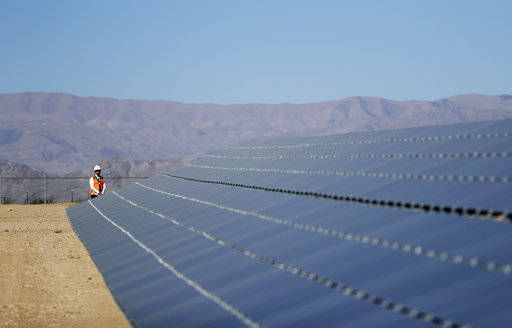Click here to subscribe today or Login.
LAS VEGAS (AP) — Elected officials and tribal leaders helped Friday to power up a sun-to-electricity array that, in 2012, was the first utility-scale power production plant approved by the U.S. Interior Department on Indian land.
The 250 megawatts generated at the Moapa Southern Paiute Solar Project, about 30 miles north of Las Vegas, will go to Los Angeles, where it could power 111,000 homes, said Georges Antoun, an executive with project owner First Solar Inc.
Tribal chairman Darren Daboda said in a statement that the first-of-its-kind project shows that even small tribes can benefit from commercial renewable energy projects.
The tribe, with about 350 members, has three solar arrays planned with private partners on its sprawling 112-square-mile Moapa River Indian Reservation.
Then-U.S. Interior Secretary Sally Jewell toured the nearly completed project last September and signed documents giving the go-ahead to another 100-megawatt plant in a partnership between the tribe and publicly-traded First Solar.
The tribe also has another 200-megawatt solar plant planned with a separate company on another part of the reservation. The tribe is perhaps best-known to Interstate 15 motorists for its travel stop and fireworks stand at a freeway exit leading to Nevada’s Valley of Fire State Park.
The Moapa Southern Paiute Solar Project array is made up of more than 3.2 million black panels, each resembling a very thin flat-screen TV, covering almost 2.2 square miles.
Nevada’s U.S. senators, Republican Dean Heller and Democrat Catherine Cortez Masto, joined state, county and Los Angeles Department of Water and Power officials for Friday’s commissioning ceremony.
Reiko Kerr, senior assistant general manager of the power company, said the clean renewable energy from the Moapa Southern Paiute Solar Project will help the goal of getting 33 percent of Los Angeles energy from renewable resources by 2020, and 50 percent by 2025.
When the project was approved, officials said the electricity purchase agreement would cost the Department of Water and Power $1.6 billion over 25 years.
First Solar bought the project in 2013 from an initial developer, K Road Power Holdings. A First Solar official said in September that a similar project might cost about $500 million.





